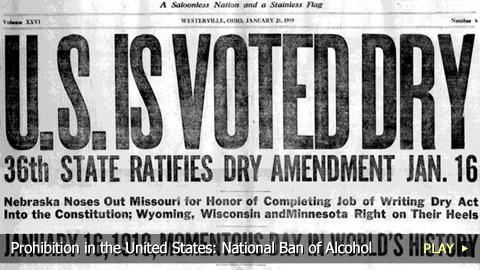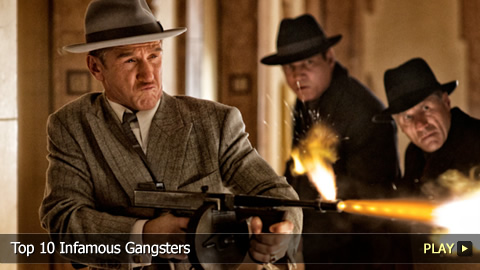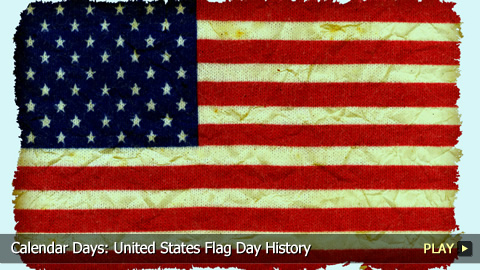Prohibition in the United States: National Ban of Alcohol

Prohibition
Prohibition in the United States was the government’s attempt to outlaw the production, sale and shipment of alcohol and intoxicating alcoholic beverages across the country.
Early Support for Prohibition
During the nineteenth century, various groups pushed for national prohibition. For instance, southern and rural populations believed a liquor ban would curtail the crime they associated with the growing number of immigrants living in American cities.
Wets and Dries
In addition, clashes arose between conflicting religious factions that were separated into the “wets” and “dries.” The dries disapproved of drinking, and considered saloons and other popular spots of alcohol consumption politically corrupt. Conversely, the wets wanted the state to remain uninvolved in discussions of morality.
Growing 20th Century Support
Support for prohibition grew, and organizations like the Anti-Saloon League lobbied for the case. Many African-Americans, women’s groups and Progressives were also in favor.
18thAmendment of the U.S. Constitution
The Eighteenth Amendment of the Constitution was the change that established the liquor ban, and it was proposed by the U.S. Senate in 1917. Two years later, it was ratified and then enabled when Congress passed the Volstead Act. This legislation was also known as the National Prohibition Act, and it identified the affected liquors and the consequences for the law’s violation.
National Prohibition Begins
Top 10 National Anthems
Prohibition went into effect on January 16th, 1920. The task of enforcing the Volstead Act was given to the federal agency known as the Prohibition Unit, which was later called the Bureau of Prohibition. This agency faced many difficulties, mainly because the urban population strongly opposed the ban and found as many ways around it as possible.
Volstead Act
For example, the Volstead Act did not expressly forbid the consumption of alcohol. Consequently, people drank alcohol they had stashed prior to the start of Prohibition. In addition, numerous Americans sought liquor prescriptions from their physicians, since the use of alcohol for medicinal purposes was exempted. Other citizens headed to bordering countries to get a drink.
Organized Crime
Meanwhile, the illegal production and sale of liquor by organized crime developed rapidly. Bootlegging emerged during the Roaring Twenties, and saw alcohol smuggled into the United States by criminals.
Gangsters and Racketeering
Top 10 Infamous Gangsters
The black market for alcohol soon fell under the control of gangsters such as Al Capone and Bugs Moran. In fact, Capone made millions through racketeering and by operating thousands of speakeasies. These establishments illegally sold liquor to their patrons, and helped popularize jazz music.
Alcohol Alternatives
Under Prohibition laws, the personal production of wine and cider made from fruit was permitted. Other individuals tried to find alternatives: some redistilled industrial alcohols to make them drinkable, and this forced the government to begin poisoning those industrial alcohols to make them undrinkable. Between all the homemade solutions, tens of thousands were poisoned or killed during Prohibition after drinking unsuitable alcohol.
St. Valentine’s Day Massacre
Calendar Days: United States Flag Day History
As the decade progressed, support for Prohibition dwindled. While the ban did succeed in reducing alcohol consumption, it also caused a spike in violent criminal activity. This was made especially evident by the St. Valentine’s Day Massacre of 1929 when several members of Moran’s mob were murdered, allegedly by Capone’s gang.
Disillusionment and the Great Depression
The American people also felt Prohibition was encroaching on their freedoms. Disillusionment reached an all-time high during the Great Depression, and this eventually led to the development of a repeal movement.
Repeal Movement
The first signs of success came in 1933, when the Senate passed the Blaine Act to instigate the repeal of the Eighteenth Amendment. This was followed by an amendment to the Volstead Act called the Cullen-Harrison Act that permitted the production and sale of particular types of liquor.
Prohibition Repealed
A few months later, the Twenty-first Amendment was ratified. This repeal of Prohibition permitted individual states to implement their own laws regarding alcohol.
Boost to the Economy
This caused the black market to suffer a huge loss in profits; however, with America’s alcohol brewing industry back in business, the official economy received a much-needed boost. While some towns continued to impose restrictions following the official repeal, the Prohibition Era was most definitely over.



